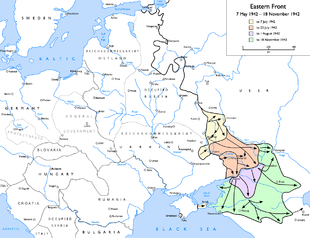
Back Slag van Stalingrad Afrikaans Batalla de Stalingrado AN معركة ستالينغراد Arabic معركة ستالينجراد ARZ Batalla de Stalingráu AST Stalinqrad döyüşü Azerbaijani ایستالینقراد دؤیوشو AZB Сталинград алышы Bashkir Patempuran Stalingrad BAN Сталінградская бітва Byelorussian
| Battle of Stalingrad | |||||||||
|---|---|---|---|---|---|---|---|---|---|
| Part of the Eastern Front of World War II | |||||||||
 The Barmaley Fountain, one of the symbols of Stalingrad, in 1943, right after the battle | |||||||||
| |||||||||
| Belligerents | |||||||||
|
| |||||||||
| Commanders and leaders | |||||||||
| Units involved | |||||||||
| Strength | |||||||||
Initial:
|
Initial:
| ||||||||
| Casualties and losses | |||||||||
|
See casualties section. |
See casualties section. | ||||||||
Location of Stalingrad (now Volgograd) within modern European Russia | |||||||||

The Battle of Stalingrad (1942-1943) was fought during the Second World War between Nazi Germany led by Adolf Hitler and the Soviet Union led by Joseph Stalin . They were fighting for control of the city of Stalingrad. Germany got support from Italy, Hungary, Croatia and Romania . The battle was fought between 23 August 1942 and 2 February 1943. It was one of the most important battles of the war because it marked the end of Germany's advances. Hitler even blamed his defeat partly on Stalingrad. The Battle of Stalingrad has often been recorded as an example of how brutal a war can be. It is reported that, due to limited supplies, soldiers and civilians had to resort to eating rats, mice, and even cannibalism.
Stalingrad, now Volgograd, was a city on the Volga River. It was an important industrial city, and the Volga was an important transport route. Hitler also wanted to capture Stalingrad because it was named after Joseph Stalin, the leader of the Soviet Union, thus it would embarrass him.
In June 1942, Adolf Hitler launched an attack in southern Russia. By the end of July the German army had reached Stalingrad. With bombs and fire the German Luftwaffe turned the city into ruins. However, the rubble made hiding places from which Russian snipers could attack the Germans. Hitler and Stalin sent in large numbers of soldiers. They both ordered that anyone who retreated would be shot on the spot for treason.
On 19 November 1942, the Red Army launched an attack which surrounded the Stalingrad area, pinching off the German salient. Hitler ordered the army to stay there. The German air force tried to supply them by air. By February 1943, the German forces in Stalingrad had no ammunition and food. Rather than freeze, they surrendered, knowing the Soviets were usually cruel to their prisoners.
The battle lasted five months, one week, and three days. 1.6 million people dead or wounded in battle were reported. There were more Russian deaths than German, but it was a victory for the Russians. They had killed so many Germans that Hitler's overall plan to conquer the Soviet Union, started with Operation Barbarossa, was seriously weakened. Also, the Germans failed to get control of Russian oil fields.
About one quarter of the German Sixth Army's soldiers were Eastern European volunteers called HIWIs. The Battle of Stalingrad was the largest and deadliest battle in the history of warfare.
Cite error: There are <ref group=Note> tags on this page, but the references will not show without a {{reflist|group=Note}} template (see the help page).
- ↑ Bellamy 2007
- ↑ 2.0 2.1 Bergström 2007
- ↑ Glantz 1995, p. 346
- ↑ Anthony Tihamér Komjáthy (1982). A Thousand Years of the Hungarian Art of War. Toronto: Rakoczi Foundation. pp. 144–45. ISBN 978-0-8191-6524-4. OCLC 26807671.
- ↑ 5.0 5.1 Hayward 1998
- ↑ Bergström 2006.
- ↑ 7.0 7.1 Glantz 1995, p. 134
- ↑ Великая Отечественная война 1941–1945 годов. В 12 т. — М.: «Кучково поле», 2012. — Т. 3. Битвы и сражения, изменившие ход войны. — С. 421. — 863 с. — ISBN 978-5-9950-0269-7.
- ↑ Walter Scott Dunn, Kursk: Hitler's Gamble, 1943,p.1
- ↑ Stephen Walsh, Stalingrad 1942–1943: The Infernal Cauldron, p. 164
- ↑ Jochen Hellbeck, Stalingrad: The City that Defeated the Third Reich p.12
- ↑ Dimarco, Louis A (2012-11-20). Concrete Hell: Urban Warfare from Stalingrad to Iraq. Bloomsbury Publishing. ISBN 978-1-78200-313-7.
- ↑ 13.0 13.1 13.2 Frieser 2017, p. 14.
- ↑ 14.0 14.1 14.2 Walsh, Stephen (2012). Stalingrad 1942–1943: The Infernal Cauldron. Amber Books Ltd. p. 182. ISBN 978-1-908273-98-7.
- ↑ Stein, Marcel (February 2007). Field Marshal von Manstein: The Janushead - A Portrait. Helion & Company Limited. ISBN 9781906033026.
- ↑ Cite error: The named reference
autogenerated1was used but no text was provided for refs named (see the help page). - ↑ Hill, Alexander (2016-12-24). The Red Army and the Second World War. Cambridge University Press. ISBN 978-1-107-02079-5.
